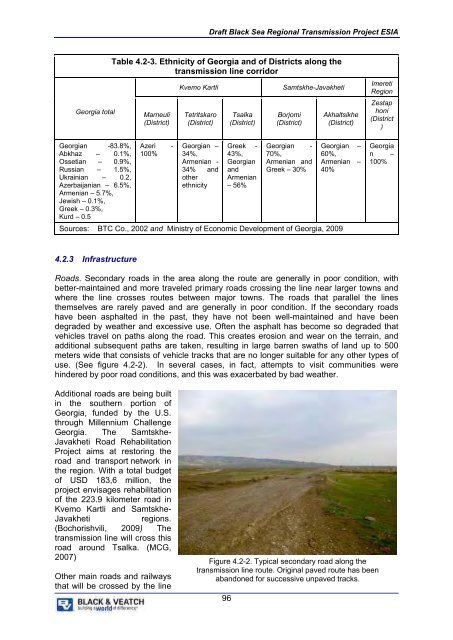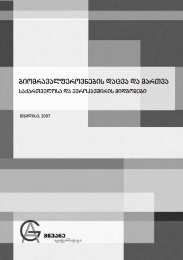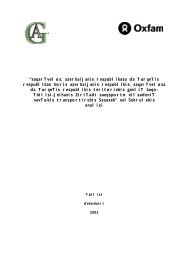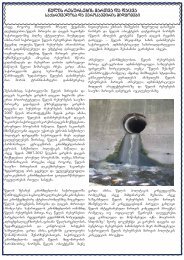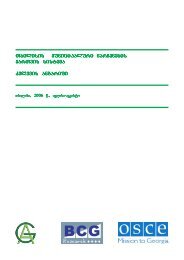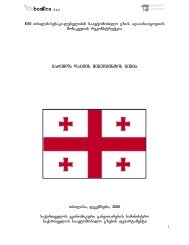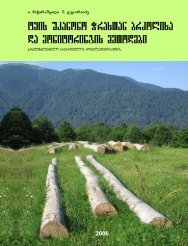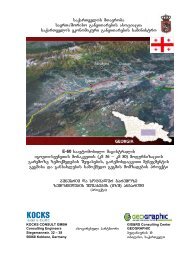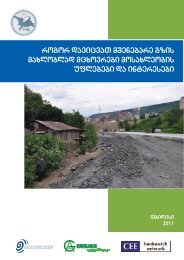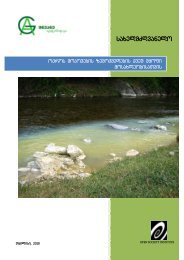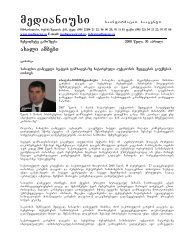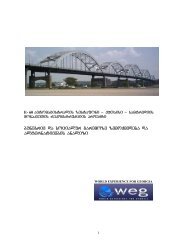Part I
Part I
Part I
Create successful ePaper yourself
Turn your PDF publications into a flip-book with our unique Google optimized e-Paper software.
Draft Black Sea Regional Transmission Project ESIA<br />
Georgia total<br />
Georgian -83.8%,<br />
Abkhaz – 0.1%,<br />
Ossetian – 0.9%,<br />
Russian – 1.5%,<br />
Ukrainian – 0.2,<br />
Azerbaijanian – 6.5%,<br />
Armenian – 5.7%,<br />
Jewish – 0.1%,<br />
Greek – 0.3%,<br />
Kurd – 0.5<br />
Table 4.2-3. Ethnicity of Georgia and of Districts along the<br />
transmission line corridor<br />
Marneuli<br />
(District)<br />
Azeri -<br />
100%<br />
Kvemo Kartli<br />
Tetritskaro<br />
(District)<br />
Georgian –<br />
34%,<br />
Armenian -<br />
34% and<br />
other<br />
ethnicity<br />
Tsalka<br />
(District)<br />
Greek -<br />
43%,<br />
Georgian<br />
and<br />
Armenian<br />
– 56%<br />
Samtskhe-Javakheti<br />
Borjomi<br />
(District)<br />
Georgian -<br />
70%,<br />
Armenian and<br />
Greek – 30%<br />
Akhaltsikhe<br />
(District)<br />
Georgian –<br />
60%,<br />
Armenian –<br />
40%<br />
Sources: BTC Co., 2002 and Ministry of Economic Development of Georgia, 2009<br />
Imereti<br />
Region<br />
Zestap<br />
honi<br />
(District<br />
)<br />
Georgia<br />
n –<br />
100%<br />
4.2.3 Infrastructure<br />
Roads. Secondary roads in the area along the route are generally in poor condition, with<br />
better-maintained and more traveled primary roads crossing the line near larger towns and<br />
where the line crosses routes between major towns. The roads that parallel the lines<br />
themselves are rarely paved and are generally in poor condition. If the secondary roads<br />
have been asphalted in the past, they have not been well-maintained and have been<br />
degraded by weather and excessive use. Often the asphalt has become so degraded that<br />
vehicles travel on paths along the road. This creates erosion and wear on the terrain, and<br />
additional subsequent paths are taken, resulting in large barren swaths of land up to 500<br />
meters wide that consists of vehicle tracks that are no longer suitable for any other types of<br />
use. (See figure 4.2-2). In several cases, in fact, attempts to visit communities were<br />
hindered by poor road conditions, and this was exacerbated by bad weather.<br />
Additional roads are being built<br />
in the southern portion of<br />
Georgia, funded by the U.S.<br />
through Millennium Challenge<br />
Georgia. The Samtskhe-<br />
Javakheti Road Rehabilitation<br />
Project aims at restoring the<br />
road and transport network in<br />
the region. With a total budget<br />
of USD 183,6 million, the<br />
project envisages rehabilitation<br />
of the 223.9 kilometer road in<br />
Kvemo Kartli and Samtskhe-<br />
Javakheti<br />
regions.<br />
(Bochorishvili, 2009) The<br />
transmission line will cross this<br />
road around Tsalka. (MCG,<br />
2007)<br />
Other main roads and railways<br />
that will be crossed by the line<br />
Figure 4.2-2. Typical secondary road along the<br />
transmission line route. Original paved route has been<br />
abandoned for successive unpaved tracks.<br />
96


